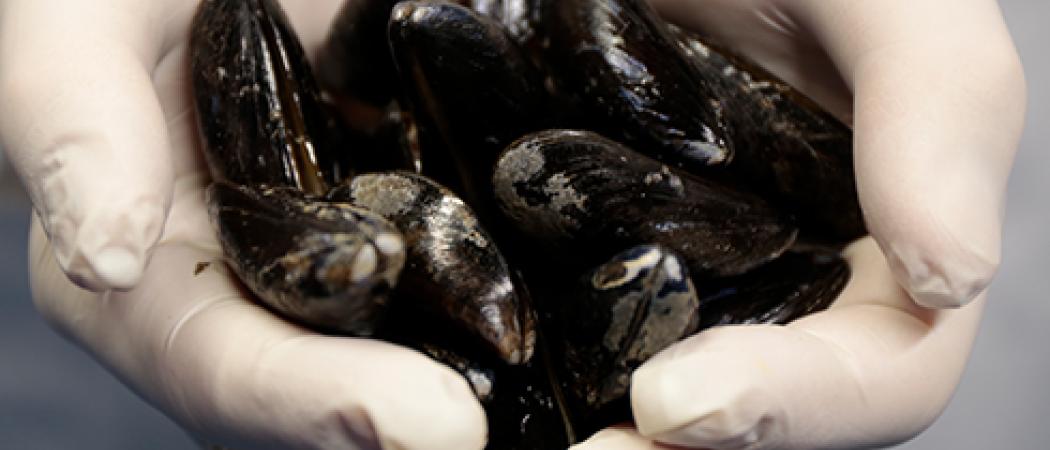Manufacturing mussel-based underwater adhesives for healing bone fractures with the help of reprogramed intestinal bacteria / spin-off planned

Biotechnological process for the production of the underwater mussel adhesive. Photo: © TU Berlin/PR/Tobias Rosenberg
UniCat scientists have reprogrammed strains of the intestinal bacteria Escherichia Coli in such a way that the biological underwater adhesive of mussels can be created with help of the bacteria. The special feature of the new biogenic super glue is that its adhesive properties can be switched on by irradiation with light. This results in long-awaited possibilities for bonding broken bones or teeth that can be fused together again through this bio-adhesive. These findings will be applied in a spin-off.
Regenerative medicine urgently needs powerful adhesives that are biocompatible – well tolerated by the organism in which they are to be used. Such adhesives could treat superficial wounds, and could replace plates and screws which are commonly used to treat bone fractures. Biological adhesive proteins could not only allow the bonding of bone fragments, but also the fusion of the bone itself.
Through collaboration in the UniCat groups of Prof. Dr. Nediljko Budisa from the TU Berlin, Prof. Dr. Holger Dobbek from the HU Berlin and Prof. Dr. Andreas Möglich, now at the University of Bayreuth, a biotechnological process was discovered, through which the biological underwater adhesive of mussels can be produced. A patent was filed for this process, and now these research results were published in the journal ChemBioChem.
Mussels mainly live in the tidal and shelf areas of the oceans. There, they must withstand strong currents and salt water. Mussels use a super adhesive to be able to hold on to the seabed. Even in low tides, when mussel beds are no longer covered by water, the adhesive still has to work. Using this adhesive, the living mussels can adhere to almost any surface. The mussel releases threads from its foot, consisting of a protein glue. The most important component of this protein glue is the amino acid 3,4-dihydroxyphenylalanine, known as "DOPA."
How do scientists produce this super adhesive?
"To create these mussel proteins, we use intestinal bacteria, which we reprogrammed," explains Nediljko Budisa. "They are like our chemical factory through which we produce the super glue." For this purpose, a special enzyme, that is obtained from the bacterium Methanocaldococcus jannaschii, was altered by the researchers and introduced into Escherichia coli. Subsequently, the modified intestinal bacteria are fed with the amino acid ONB-DOPA (ortho-nitrobenzyl DOPA). Within the ONB-DOPA molecule, the dihydroxyphenyl groups that are responsible for the strong adhesion are protected. This is similar to a sticker that has its self-adhesive surface covered by a protective film. The reprogrammed bacterium now builds these amino acids ‘wrapped in protective film’ into proteins, and a bonding protein is obtained, whose adhesive sites are still protected. It is only after the protected adhesive protein has been separated from the bacteria and purified, that the protective groups are removed by means of light of a specific wavelength (365 nm). Through this, the adhesive protein loses its – figuratively spoken – protective film. Its adhesive points are activated and the protein can be targetedly used as a glue.
Spin-off planned
The production or enrichment of Mussel Adhesion Proteins (MAPs) had not yet been satisfactorily resolved: the isolation of these organic glues from mussels and other natural sources is inefficient and expensive. Thus, only 1 to 2 grams of this super adhesive can be obtained from 10,000 mussels. Furthermore, the glue-protein from mussels cannot be obtained homogeneously; that is, each batch is different. An additional disadvantage is that the adhesive protein of the mussel must be used almost immediately due to its good adhesive properties. This new procedure from the UniCat scientists can lead to considerable improvements: an increased yield, the avoidance of animal suffering, and a more homogeneous product with adhesive properties that can be switched on.
Two scientists from Budisa’s working group are planning to establish a spin-off based on this idea that is both environmentally friendly and useful for humanity. "This strategy offers new ways to produce DOPA-based wet adhesives for use in industry and biomedicine with the potential to revolutionize bone surgery and wound healing," assert Christian Schipp and Dr. Matthias Hauf. In order to bring their business idea to life, they plan to use the Inkulab, the spin-off laboratory of the Excellence Cluster UniCat at the TU Berlin, and participate in its incubation program.
Prof. Reinhard Schomäcker, who initiated the start-up Inkulab is delighted: "Precisely for innovative ideas such as this, we founded Inkulab together with the Berlin economy. The science and business hub Berlin is greatly enriched by founding such companies. Germany benefits from this entrepreneurial spirit."
Publication
The research work on photoactivatable mussel-based underwater detachment proteins is a collaborative effort between three UniCat working groups, and has been published in the journal ChemBioChem:
Matthias Hauf, Florian Richter, Tobias Schneider, Thomas Faidt, Berta M. Martins, Tobias Baumann, Patrick Durkin, Holger Dobbek, Karin Jacobs, Andreas Möglich, and Nediljko Budisa: "Photoactivatable Mussel-Based Underwater Adhesive Proteins by an Expanded Genetic Code". ChemBioChem 2017, 18, 1819-1823, doi: 10.1002 / cbic.201700327
http://onlinelibrary.wiley.com/doi/10.1002/cbic.201700327/full
This release was first published 13 November by TU Berlin.




 A unique international forum for public research organisations and companies to connect their external engagement with strategic interests around their R&D system.
A unique international forum for public research organisations and companies to connect their external engagement with strategic interests around their R&D system.